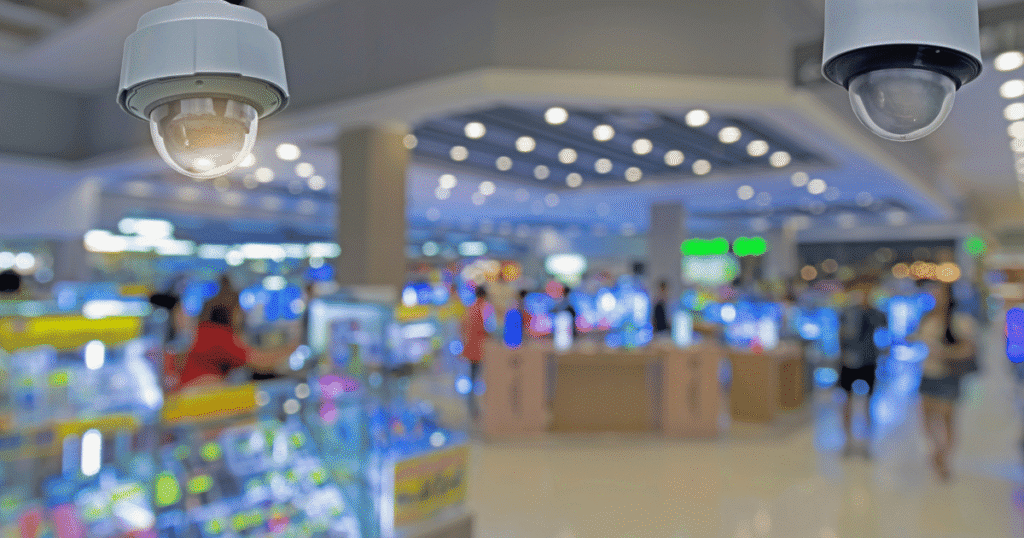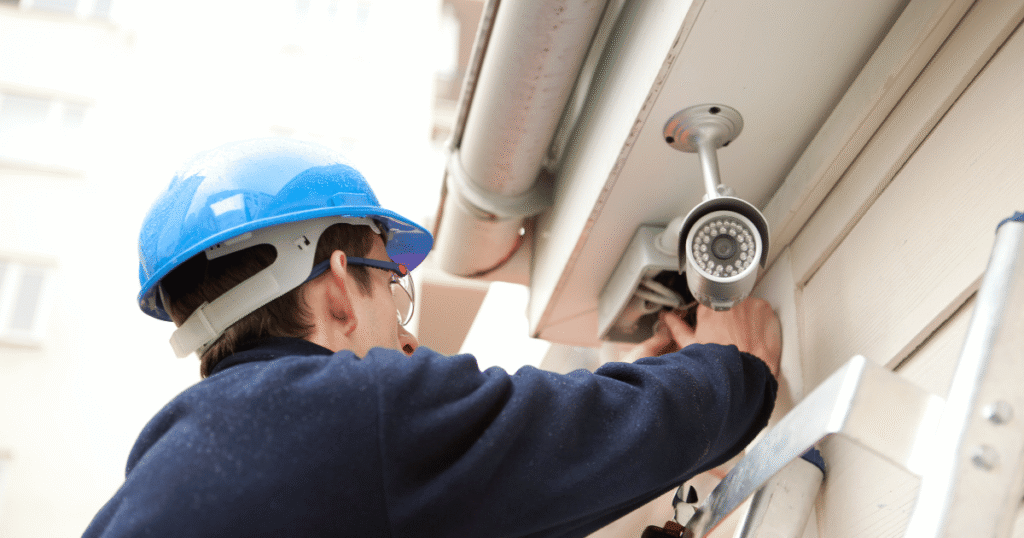
California Shop Security Systems – Protect Your Business in CA
In California, retail businesses face a challenging security landscape with over 213,000 reported retail theft incidents reaching historic highs in recent years. This staggering statistic represents countless business owners who’ve experienced the devastating impact of inadequate security measures. As retail crime continues to evolve in sophistication and scale across the Golden State, implementing robust retail protection solutions has become essential for business survival and growth.
Don’t leave your business vulnerable. Partner with SPADE Cyber Security today to safeguard your retail operations with cutting-edge security solutions. Contact us for a consultation and take the first step towards protecting your business!
Why Is Security Important for Retail Stores in California?
California retail establishments face unique security challenges that demand specialized attention. With commercial burglary rates remaining 6.8% above pre-pandemic levels, the threat to retail operations has never been more tangible. The California Department of Justice actively encourages businesses to invest in comprehensive security and surveillance technology as part of a broader strategy to combat retail crime.
The financial impact of inadequate security extends far beyond the immediate loss of merchandise. Despite significant efforts from the Organized Retail Crime Task Force, which has recovered over $45 million in stolen goods since 2019, businesses continue to shoulder substantial losses. These expenses include not just stolen inventory but also property damage, increased insurance premiums, and potential liability issues.
Advanced store protection systems provide multiple layers of defense that address these specific regional challenges. Modern security technologies not only deter criminal activity but also provide valuable evidence for law enforcement when incidents occur. The investment in quality commercial security solutions pays dividends through reduced shrinkage, improved employee safety, and enhanced customer confidence.
Regional Security Challenges: Sacramento, El Dorado, and Yolo Counties
Security needs vary significantly across California’s diverse regions. Sacramento County has experienced particularly troubling trends, with retail theft (including shoplifting and commercial burglaries) rising by nearly 70% from 2019 to 2023. This dramatic increase makes Sacramento one of four counties responsible for over 90% of California’s total rise in retail theft during this period.
Commercial robberies in Sacramento increased by 29% from 2019 to 2022, the steepest rise among major urban counties in the state. This trend highlights why Sacramento retailers need particularly robust security measures tailored to their higher risk profile.
In contrast, El Dorado and Yolo counties present a different security landscape. As smaller counties outside major urban centers, they’ve generally experienced stable or declining rates of retail theft during the same period. However, their proximity to Sacramento means retailers in these areas should remain vigilant as criminals often shift their activities when enforcement increases in nearby high-crime areas.

Core Components of a Retail Security System
Modern retail security systems have evolved significantly beyond basic alarms and locks. Today’s comprehensive protection integrates multiple technologies to create layered defense against increasingly sophisticated threats. When properly implemented, these systems work in harmony to safeguard your business assets, employees, and customers.
Surveillance Cameras: Options and Placement Strategies
Video surveillance with AI integration represents the cornerstone of effective retail security. Modern security cameras now offer unprecedented capabilities that extend far beyond simple recording. High-definition cameras with artificial intelligence can analyze footage in real-time, automatically detecting suspicious behaviors such as loitering, package abandonment, or unusual movement patterns around high-value merchandise.
Strategic camera placement is critical for maximum effectiveness. Coverage should include all entry/exit points, register areas, stockrooms, and blind spots where shoplifting commonly occurs. Many security providers recommend a combination of visible deterrent cameras and discreet monitoring devices. Dome cameras work well for general coverage, while directional bullet cameras provide focused monitoring of specific areas like cash registers or jewelry displays.
For optimal effectiveness, modern systems incorporate remote viewing capabilities, allowing store owners to monitor their premises from anywhere via smartphone or tablet. This technology integration ensures you maintain visibility even when physically absent from your location.
Intrusion Detection Systems: Types and Effectiveness
Intrusion detection forms another crucial layer in comprehensive security. These systems utilize various sensor types to detect unauthorized access attempts during closed hours. Modern solutions incorporate motion sensors, glass-break detectors, door/window contacts, and vibration sensors that trigger immediate alerts when security is compromised.
The effectiveness of these systems depends largely on proper installation tailored to your specific retail environment. Professional installation ensures sensors are positioned optimally and calibrated correctly to minimize false alarms while maximizing detection capabilities. When connected to monitoring services, these systems enable rapid response from security personnel or law enforcement when breaches occur.
For California retailers, dual-technology sensors that require two different types of detection before triggering an alarm have proven particularly effective at reducing false alarms while maintaining security integrity.
Access Control Systems: Ensuring Authorized Entry Only
Smart access control represents a significant advancement in retail security, allowing precise management of who enters sensitive areas of your business. These systems replace traditional keys with digital credentials that can be instantly issued, modified, or revoked as personnel changes occur. For specialized retailers handling high-value inventory, this capability provides crucial protection against insider theft.
A properly configured access control solution might include card readers, keypad entry systems, or even biometric scanners for areas requiring heightened security. The systems maintain detailed logs of all access attempts, creating an audit trail that proves invaluable during security investigations. Many retailers implement tiered access levels, restricting stockroom or office entry to specific employees while maintaining convenient access to customer-facing areas.
Cloud-based access control systems offer particular advantages for multi-location retailers, allowing centralized management of security permissions across numerous California locations from a single interface.
Fire Alarm Systems: Protecting Against Fire Hazards
Fire protection represents an essential but often overlooked component of comprehensive retail security. Beyond protecting your inventory and physical structure, these systems safeguard human lives. Advanced fire alarm systems incorporate smoke, heat, and carbon monoxide detectors strategically positioned throughout your retail space.
Professional security installations ensure these components meet California’s specific fire code requirements while integrating seamlessly with your overall security infrastructure. Modern systems offer addressable technology that pinpoints the exact location of a fire’s origin, enabling faster response and potentially reducing damage. When connected to monitoring services, these systems automatically alert emergency services even when the premises are unoccupied.
Many security providers now offer systems that integrate with emergency lighting, PA systems, and automatic door releases to facilitate swift evacuation during emergencies while simultaneously alerting first responders.
Integrated Security Solutions: Benefits of System Synergy
The true power of modern retail security emerges when these components work together as a unified system. Integrated security connects surveillance, intrusion detection, access control, and fire protection through a central management platform. This integration creates powerful synergies that enhance overall protection while simplifying day-to-day security management.
For example, when an access control system detects an unauthorized entry attempt, it can automatically direct cameras to the affected area, trigger recording at higher frame rates, and send instant alerts with video verification to security personnel. This coordinated response dramatically improves incident management efficiency.
Leading security technologies now incorporate cloud-based management interfaces that provide comprehensive control through user-friendly dashboards accessible from any device. This technology allows California shop owners to monitor multiple locations, adjust security parameters, and respond to incidents in real-time, regardless of their physical location.
Tailoring Security Solutions to Different Types of Shops
Security requirements vary dramatically across California’s diverse retail landscape. From small boutiques to sprawling department stores, from jewelry retailers to electronics shops, each business faces distinct security challenges. Understanding these unique needs is essential for implementing effective security technology that protects your specific business assets without creating operational obstacles or customer experience issues.
Security Needs for Large vs. Small Retail Shops
Large and small retail establishments face fundamentally different security challenges that demand tailored approaches. Large retailers typically enjoy substantial security budgets, allowing for comprehensive technology solutions that include extensive camera networks, dedicated security personnel, and sophisticated anti-theft systems. Their scale provides a financial cushion against occasional losses that smaller businesses simply don’t have.
For small retailers operating on narrow profit margins, every security investment must deliver maximum impact. Budget-friendly security packages must focus on the most critical vulnerabilities while remaining affordable. According to industry research, small retailers are often specifically targeted by criminals who recognize their potentially weaker security infrastructure compared to nearby larger stores—a phenomenon security experts call “displacement.”
SPADE Security Services, a veteran-owned company serving Sacramento, El Dorado County, and Yolo County, specializes in addressing this security gap for small to mid-sized retailers. Their approach integrates essential security elements with advanced technologies like AI-driven surveillance, providing smaller shops with enterprise-level protection at accessible price points. Their remote video surveillance services offer particular value to small retailers who cannot afford full-time security personnel but need active monitoring.
Special Considerations for Specialized Retailers (e.g., Jewelry, Electronics)
High-value retailers such as jewelry stores and electronics shops require specialized security solutions that address their unique vulnerabilities. With merchandise values often reaching thousands of dollars per square foot, these businesses face heightened theft risks that demand sophisticated countermeasures.
Case Study: Tilly’s Retail Success Tilly’s, a popular retail chain with locations throughout California, implemented enhanced cybersecurity measures and PCI DSS compliance across hundreds of locations. By working with security experts to protect both customer payment data and store infrastructure, they achieved full PCI DSS compliance across their locations, significantly reducing both data breach risks and bolstering their overall store security posture.
For jewelry retailers, advanced surveillance systems with high-definition cameras covering all display cases are essential, preferably with zoom capabilities that can capture detailed facial features and identifying characteristics. SPADE Security Services’ integrated approach combines traditional security cameras with AI-powered analytics that can identify suspicious behaviors—like someone examining multiple high-value items without making purchases—and alert staff before theft occurs.
Electronics retailers benefit from electronic article surveillance (EAS) systems combined with specialized security tags designed for their products. Many security technologies now integrate inventory management systems with security infrastructure, allowing immediate detection when items leave authorized areas without proper checkout procedures.
Both industries should consider display cases with built-in alarm systems that trigger alerts when unauthorized access occurs. Access control systems using biometric verification or electronic credentials protect back-room inventory from both external threats and potential insider theft—a significant concern for high-value retail operations.
Adapting Security Systems in High-Traffic Tourist Areas
California’s popular tourist destinations present unique security challenges for retailers. With transient customer populations and crowded shopping environments, businesses in these areas face elevated risks that require adaptive security approaches.
The rise of organized retail theft has hit California’s tourist areas particularly hard, with sophisticated criminal groups employing tactics like flash-mob style thefts and smash-and-grab robberies that can quickly overwhelm standard security measures. These incidents have contributed to retail crime losses exceeding $112 billion nationwide, with California remaining a notable hotspot for such activities.
Success Story: Sacramento’s Data-Driven Approach The Sacramento Organized Retail Crime Task Force has demonstrated how data-driven partnerships between police, prosecutors, and retailers can dramatically improve security outcomes. By implementing enhanced data sharing between private retailers, law enforcement, and prosecutors, the task force has improved prosecution rates and achieved more effective crime prevention outcomes. The collaborative approach helps stakeholders identify regional theft trends and organized retail crime groups while improving case preparation for successful prosecution.
Effective security strategies for tourist-area retailers include visible deterrents combined with discreet monitoring systems. SPADE Security Services offers vehicle patrol options that provide regular security presence while their drone video surveillance capabilities offer unprecedented aerial monitoring during peak shopping periods or special events—a technological advantage that conventional security services cannot match.
Managing security in high-traffic environments also requires sophisticated crowd monitoring capabilities. Advanced security technologies now incorporate people-counting analytics, queue management, and anomaly detection algorithms that can identify potentially problematic situations before they escalate. These systems help maintain a welcoming atmosphere for legitimate shoppers while enabling swift response to security issues.

California-Specific Security Regulations and Compliance
California retailers must navigate specific regulatory requirements when implementing security systems. Understanding these requirements is essential for both compliance and maximizing the effectiveness of your security investment.
Workplace Violence Prevention Plan (SB 533)
Effective July 1, 2024, California requires nearly all employers — including retailers — to develop and implement a comprehensive workplace violence prevention plan. This groundbreaking legislation requires retailers to:
- Create and maintain a written workplace violence prevention plan
- Conduct workplace violence training for all employees
- Keep detailed records, including an incident log for every workplace violence incident and its investigation
This mandate directly impacts how retailers plan and justify their security system installations and employee training programs. SPADE Security Services helps retailers develop compliant prevention plans that integrate with their physical security systems for a comprehensive approach.
Employee Privacy and Camera Placement Regulations
California’s robust privacy laws — such as the California Consumer Privacy Act (CCPA) — shape how retailers deploy security cameras. Key requirements include:
- Cameras cannot be installed in areas where employees or customers have a reasonable expectation of privacy (restrooms, changing rooms)
- If cameras capture personally identifiable information, retailers must comply with CCPA requirements regarding notice, use, storage, and sharing of video footage
- Employers must notify employees about surveillance practices
Professional security providers ensure your camera systems comply with these regulations while still providing effective coverage of critical areas.
Documentation and Record-Keeping Requirements
Under California’s workplace violence prevention requirements, careful documentation is mandatory, including:
- Maintaining an incident log for all workplace violence events and their investigations
- Retaining training records and documentation of compliance with the prevention plan
- Ensuring security system footage is stored in accordance with legal requirements for potential evidence
SPADE Security Services helps retailers implement compliant documentation systems that satisfy both regulatory requirements and practical security needs.
Choosing the Right Security Provider in California
Selecting the right security provider is perhaps the most critical decision you’ll make in protecting your retail business. California’s unique regulatory environment, diverse retail landscape, and specific security challenges require partnering with professionals who understand these nuances. The right security partner will not only address your immediate security concerns but also help future-proof your business against evolving threats.
When evaluating potential security installation services for your business, several factors deserve careful consideration. First and foremost is compliance with California’s stringent licensing requirements. Any reputable commercial security company must hold an Alarm Company Operator (ACO) license issued by the Bureau of Security and Investigative Services (BSIS). This licensure ensures the provider meets state-mandated professional standards and operates legally within California.
SPADE Security Services, a veteran-owned company serving Sacramento, El Dorado County, and Yolo County, maintains all required state credentials while offering innovative security solutions that go beyond traditional approaches. Founded by Marine Corps veteran Pranil Shankar, SPADE brings over 20 years of security expertise to retail businesses facing increasingly sophisticated threats.
Case Study: Advanced License Plate Recognition Systems California businesses using advanced license plate recognition (ALPR) and video systems have reported significant reductions in crime, with some citing up to a 60% decrease in criminal incidents where these systems are actively deployed. These technologies enable identification of vehicles linked to theft incidents, leading to quicker apprehensions and deterring organized retail theft attempts. SPADE Security Services has implemented similar technologies for Sacramento retailers, achieving comparable results through their integrated security approach.
Before committing to any security provider, request a thorough on-site security assessment. Professional security experts should evaluate your property’s unique characteristics, including layout, traffic patterns, existing vulnerabilities, and specific inventory risks. SPADE’s assessment process incorporates both conventional risk analysis and cutting-edge approaches that leverage their experience with drone surveillance and AI-driven security solutions.
The breadth of offered services represents another crucial consideration. Modern retail security demands integrated solutions that address both physical and digital vulnerabilities. SPADE’s comprehensive service portfolio includes traditional elements like security system installation and guard services alongside innovative offerings such as drone video surveillance, cyber security protection, and remote monitoring capabilities. This multifaceted approach ensures all potential security gaps receive appropriate attention.

Maintaining and Upgrading Your Shop's Security System
Installing a state-of-the-art security system is only the beginning of your retail security journey. Without proper maintenance, timely upgrades, and comprehensive staff training, even the most sophisticated security technology can fail when you need it most. Establishing a proactive approach to security system management ensures your investment continues to protect your business effectively against evolving threats.
Regular Maintenance and Its Importance
Regular maintenance serves as the foundation of effective security system operation. Even the most advanced commercial security solutions require consistent attention to function optimally. Security cameras collect dust that can obscure lenses, access control readers experience wear from daily use, and detection sensors may need recalibration to maintain accuracy. Implementing a scheduled maintenance program prevents these minor issues from becoming major vulnerabilities.
Many security providers offer maintenance agreements that provide periodic inspections, cleaning, testing, and necessary adjustments. These agreements typically include verification that all system components communicate properly, firmware updates that patch security vulnerabilities, and battery replacements for backup power systems. For retailers with multiple locations, centralized maintenance tracking ensures consistent protection across all properties.
The financial implications of neglected maintenance can be severe. When systems fail during security incidents, retailers face not only potential losses from theft or vandalism but also increased insurance premiums and possible liability issues. Conversely, documented maintenance records often support insurance claims and demonstrate due diligence in protecting your business assets.
Signs It’s Time to Upgrade Your Security System
Security technology evolves rapidly, introducing new capabilities that can significantly enhance your protection strategies. Several clear indicators suggest your system may require updating to maintain effective security coverage:
- Frequent false alarms or component failures
- Poor image quality that prevents clear identification of individuals
- Limited or no remote access capabilities
- Inability to integrate with other business systems
- Outdated technology that lacks advanced analytics or AI capabilities
Changes in your business operations also necessitate security system reassessment. Expanding retail floor space, adding high-value merchandise sections, or increasing operating hours all create new security challenges that your original system may not adequately address. Professional security experts can evaluate whether your existing infrastructure can be enhanced or if a more comprehensive upgrade would better serve your evolving needs.
Many retailers find that upgrading makes financial sense even when existing systems still function. Newer security technologies often offer reduced power consumption, lower maintenance requirements, and enhanced remote management capabilities that decrease overall operational costs. Additionally, modern systems typically provide superior cybersecurity protection—an increasingly important consideration as more security devices connect to business networks.
Training Employees on Security Protocols and System Use
The effectiveness of any security system ultimately depends on the people who interact with it daily. Comprehensive employee training transforms your staff from potential security vulnerabilities into valuable security assets. When implementing new commercial security solutions or upgrading existing systems, allocate sufficient resources for thorough staff training that covers both system operation and security protocols.
Training should include hands-on practice with security equipment relevant to each employee’s responsibilities. Register operators need to understand how to respond to EAS system alerts, while managers require deeper knowledge of surveillance system operation and access control management. Regular refresher training keeps security awareness high and accommodates staff turnover in retail environments.
Security protocols should be documented clearly in accessible formats that staff can reference when needed. These protocols should cover routine security procedures as well as emergency response guidelines for various scenarios including robbery, shoplifting, and aggressive customer behavior. Role-playing exercises can help employees develop the confidence to implement these protocols effectively when real situations arise.
Conclusion: Protecting Your California Retail Business
As retail crime continues to evolve across California, particularly in high-risk areas like Sacramento where theft incidents have increased by nearly 70% since 2019, implementing effective security has become a business necessity rather than an option. The right security approach combines advanced technology, professional expertise, and ongoing management to create a comprehensive shield against today’s sophisticated retail threats.
SPADE Security Services offers California retailers a unique combination of traditional security expertise and innovative technologies tailored to their specific needs. As a veteran-owned company with deep roots in Sacramento, El Dorado County, and Yolo County, SPADE understands the local security landscape and the challenges retailers face in each community.
Don’t wait for a security incident to highlight vulnerabilities in your current protection strategy. Contact SPADE Security Services today for a comprehensive security assessment that will identify potential risks and recommend tailored solutions. Our team of security experts will work with you to develop a protection plan that safeguards your assets, employees, and customers while meeting your operational and budgetary requirements.
Take the first step toward superior retail security by calling 1-888-772-3301 or visiting our website at spadesecurityservices.com to schedule your consultation.
Frequently Asked Questions About Retail Security in California
How much does a comprehensive retail security system typically cost in California?
Security system costs vary widely based on store size, layout, inventory value, and specific security needs. Basic systems for small retailers might start around $2,500-5,000, while comprehensive solutions for larger stores or high-value retailers can range from $10,000 to $50,000+. SPADE Security Services offers flexible pricing options and can design systems that maximize protection within your budget constraints.
What security technologies are most effective for preventing organized retail theft?
Organized retail theft requires a multi-layered approach combining:
- High-definition surveillance with AI-powered analytics
- Electronic article surveillance (EAS) systems
- Access control for sensitive areas
- License plate recognition for parking areas
- Integration with regional retail crime databases
SPADE Security Services specializes in implementing these coordinated solutions to address sophisticated criminal operations.
How long does security system installation take, and will it disrupt my business operations?
Installation timelines depend on system complexity and store size, typically ranging from 1-5 days. SPADE Security Services minimizes business disruption by conducting major installation work during off hours when possible and staging the implementation to keep critical business functions operational throughout the process.
What are my obligations under California’s new Workplace Violence Prevention Plan requirement (SB 533)?
Starting July 1, 2024, California retailers must:
- Develop a written workplace violence prevention plan
- Provide employee training on workplace violence prevention
- Maintain incident logs and investigation records
- Implement appropriate security measures
SPADE Security Services can help you develop a compliant plan that integrates with your physical security systems and supports both regulatory compliance and practical protection.
Can security systems integrate with my existing business management software?
Modern security systems can integrate with various business applications including:
- Point of sale (POS) systems
- Inventory management
- Employee scheduling
- Building management systems
- Customer analytics
This integration creates operational efficiencies while enhancing security. SPADE’s technical team specializes in creating seamless connections between security technologies and business management systems.




